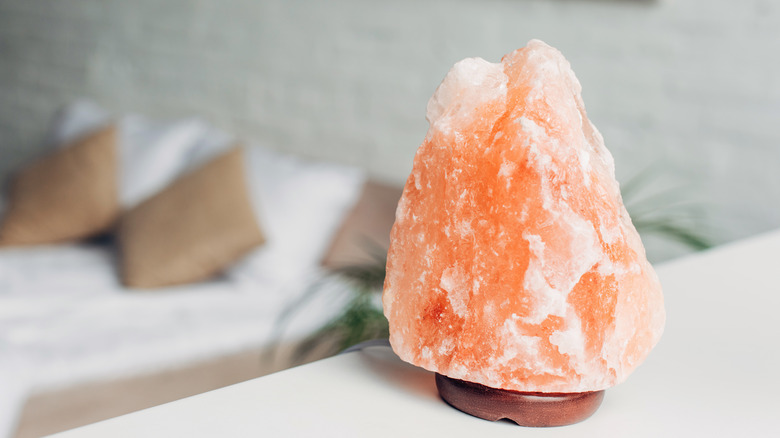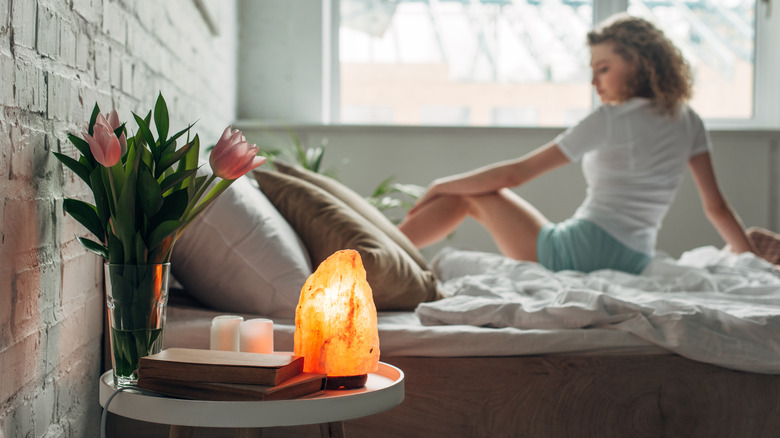Are Himalayan Salt Lamps Really The Secret To Purer Air In A Home?
We may receive a commission on purchases made from links.
Have you ever visited the beach and found that you could breathe easier? This phenomenon is nothing new; the effects of salt water and salty air have been observed since the 12th century. One of the first scientific studies into salt or halotherapy was conducted by Polish doctor Feliks Boczkowski. He began his study after noticing that salt miners did not have respiratory ailments that were typically prevalent amongst miners. Modern-day salt rooms have sought to mimic the experience of going to a beach or sitting in salt caves. Additionally, salt lamps were created to get similar results at home. Retailers claim that Himalayan salt lamps are the secret to purer air, positive mood, and better sleep.
The claims are impressive and tempting but highly debatable. Reviews on Amazon suggest a positive experience, but many comments refer to the lamp's aesthetics rather than its health benefits. The research on salt lamps is minimal, and scientific studies on the lamps have been limited to mice. While they may improve your mood and serve as a mild anti-depressant, there is no conclusive evidence that Himalayan salt lamps will impact air quality. When concerned about air quality, consider plants to help purify the air in your home. They may not glow, but they will improve air quality.
What do salt lamps do?
Manufacturers make many claims about Himalayan salt lamps. Himalayan Trading Co., who call themselves the original maker of salt lamps, lists many health benefits on their official website. They say their Himalayan salt lamps will help you sleep, feel, and breathe better. The benefits rely on the lightbulb inside. When the lightbulb heats the large chunk of salt, the mineral supposedly begins to release negative ions that entrap impurities, allergens, and dust particles in the air. The negative ions are also said to increase serotonin, a chemical that can combat depression.
The salt, or halite, is said to absorb airborne water particles and release purified water vapor. This chemical reaction is caused when the low-watt lightbulb inside the mineral heats up. The salt itself is typically only warm to the touch and poses little risk when running all day. In fact, Himalayan Trading Co. suggests continuous use for the most benefits and to avoid the build-up of moisture, which can be the enemy of halite.
Do Himalayan salt lamps actually purify the air?
Though halotherapy has been shown to have a positive impact on breathing and is even suggested as a complementary respiratory treatment, salt lamps are considered ineffective. There are no significant scientific studies that support the claims made by salt lamp retailers. The science behind the claims, however, is still being studied. Negative ions like those created by an air ionizer may have some ability to trap some virus pathogens and mold spores, but it is unlikely that they will purify the air.
Allergen particles like pollen are larger than bacteria and, therefore, are too dense to be trapped by negative ions. Even if a Himalayan salt lamp were capable of producing negative ions, they would still be an ineffective air purification device. Salt lamps won't do anything for your air quality, but their gentle brightness could affect your mood. They have a natural appearance and a soft glow that promotes relaxation. Salt lamps are attractive décor but do not deliver on their many claims. So, if you need an air purifier, consider a Corsi-Rosenthal cube, an easy DIY project that's been shown to radically change the air quality of a room.


